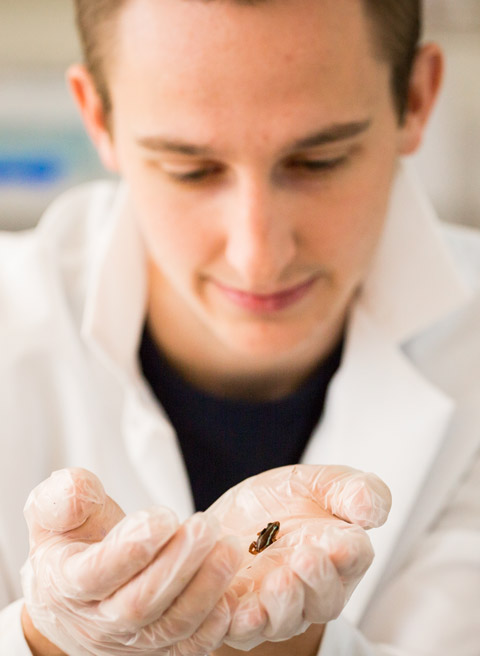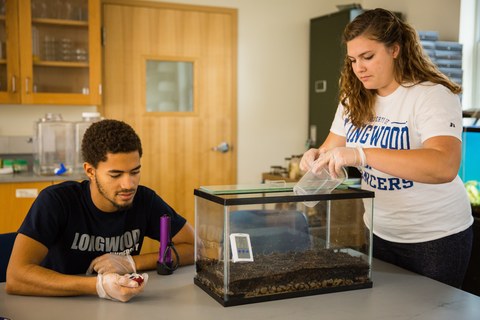Every morning at 8 o’clock this semester, even weekends, one of five students from a Longwood University ecology class walks across campus with food on his or her mind. Pancakes at the dining hall? No—feeding poison dart frogs in the science building.
Each mealtime in the lab, the student drops 10 wingless, calcium powder-dusted fruit flies into a glass-topped aquarium, then records how long it takes the frogs—individually, in pairs, or in groups of three that are reshuffled every three days—to eat them.
"The frogs all have a personality. Some, we’ve learned, are hungrier than others," said Devin Straub ’17. "When there are two frogs in the tank, they will eat faster than if it’s just one, and, when there are three frogs, they’ll eat faster than when there are two." Added Maddie Sodikoff ’18, "If there are three frogs, two will eat all of the flies, and the other won’t eat any."
The early morning experiments might eventually shed light on a poorly understood biochemical process that creates the frogs’ bright colors, a defense mechanism that warns predators to keep their distance. The colors result from chemicals the frogs ingest as a part of their natural diet and then store in their skin in a process called sequestration. In the first phase of a longterm research project, the students and biology lecturer Dr. Jeff Bardwell are investigating the role that diet plays in sequestration. The work also might yield information on plant biodiversity in the frogs’ native habitats.
At the center of the research is a family of chemicals called alkaloids. "We know the frogs ingest hundreds of alkaloids but preferentially sequester only a few," said Bardwell, a behavioral ecologist. "We want to know why and how they sequester the ones they do."
The students are using six captive-bred poison dart frogs—nontoxic, unlike their highly toxic counterparts in the wild—that Bardwell keeps in a vivarium in his office. The tiny, bold-colored frogs are from a species called Epipedobates anthonyi.
Bardwell is interested specifically in how these frogs sequester epibatidine, a nicotine-related analgesic alkaloid, to examine the relationship between alkaloid structure and sequestration preference. Because epibatidine is 200 times stronger than morphine but not habit-forming, pharmaceutical companies are trying to produce a less toxic derivative with analgesic properties, which has shown promise.
Epibatidine and other alkaloids, a diverse group of organic compounds, are absorbed from unknown invertebrates, likely beetles, ants or mites, that the frogs eat in the wild. The insects acquire and/or synthesize alkaloids from plants, said Bardwell.
"Frog populations often act as ecological and biochemical indicators of the state of their respective habitats," he said. "With poison dart frogs, plant-based alkaloids are sequestered over the course of the frogs’ lifetimes, turning them into biochemical catalogs of local rainforest flora. This field of study offers new insights into global hotspot biodiversity within rain forest ecosystems. Save the frogs; save the world."

Keith Cochran ’16 holds one of the tiny frogs he helped feed.
Foraging behavior has been the students’ research focus so far. They’ve been taking turns with the feeding duties, which began Sept. 29 and ended Nov. 18, using small vivaria in Bardwell’s office. Every morning, the students must examine the animals’ hind limbs—marked with unique pink tags that fluoresce under ultraviolet light—to identify their frogs before administering breakfast.
In addition to collecting and analyzing data, the students are conducting a literature review of poison dart frogs. They will write research manuscripts that will be combined into one article that Bardwell will submit to the Journal of Herpetology at the end of the semester.
"The most interesting thing about poison dart frogs is their tongues, which are awesome. Some species can move their tongue independently of their head," said Straub. "It’s also cool that some of them are dangerous and can kill you."
The other students in the class are Jessica Anderson ’17, Keith Cochran ’16 and McCoy Williams ’18.
In addition to 10 harmless Epipedobates frogs in Bardwell’s office are three golden poison dart frogs (Phyllobates terribilis), which are considered one of the most toxic animals on earth. "Columbian natives use a lethal alkaloid these frogs secrete [batrachotoxin] to poison their darts," he said.
Bardwell switched his main research focus, previously turtles’ basking behavior, to poison dart frogs as a result of an August 2014 faculty development retreat he went on in the Ecuadorian Amazon rain forest. The retreat focused on the environmental plight caused by oil drilling that is threatening the rain forests, including the indigenous tribes who live there.
"My ecology class next semester, as well as any other students who wish to join the fun, will continue this research and expand on it. We’re just getting started," said Bardwell.



Leave a Comment